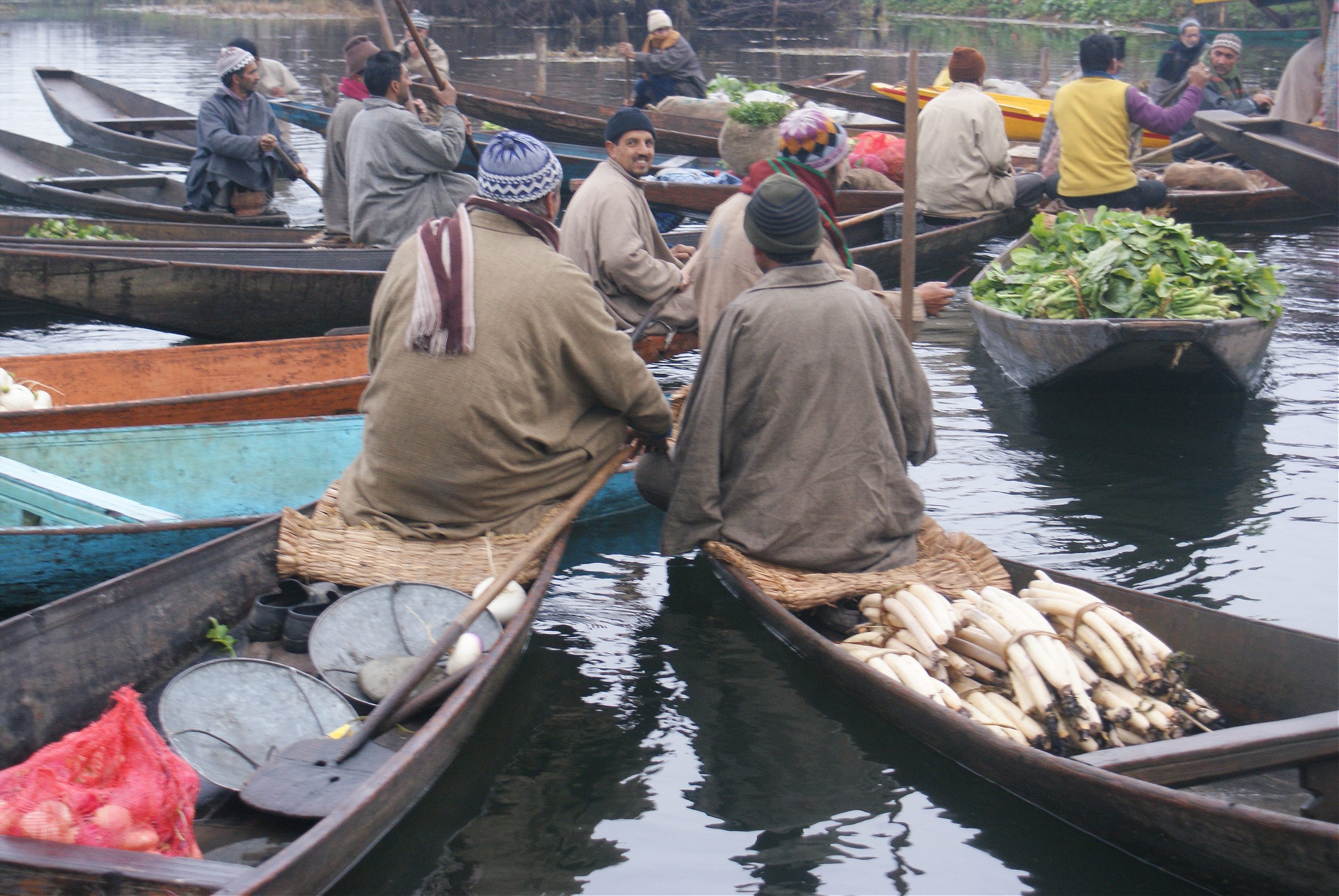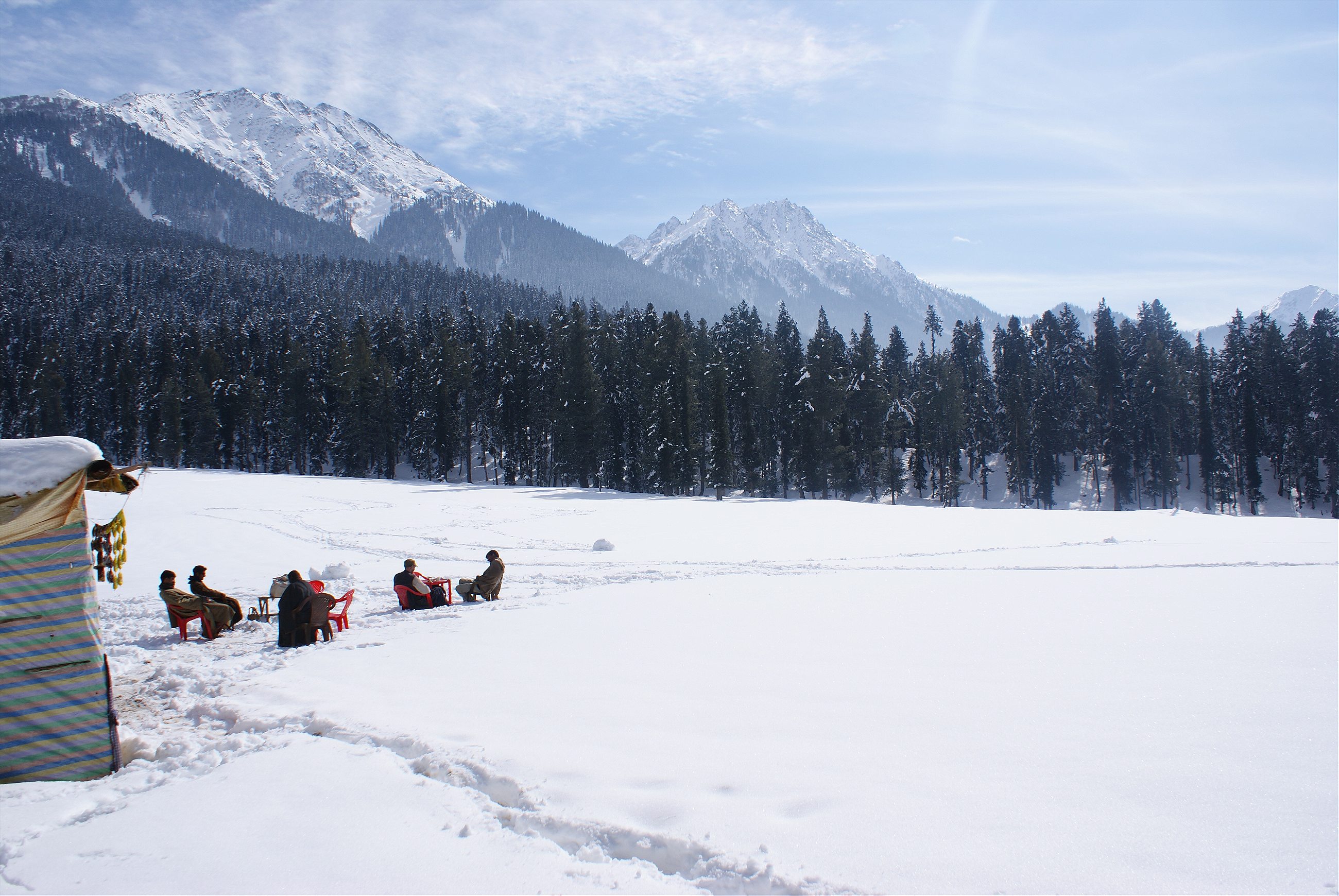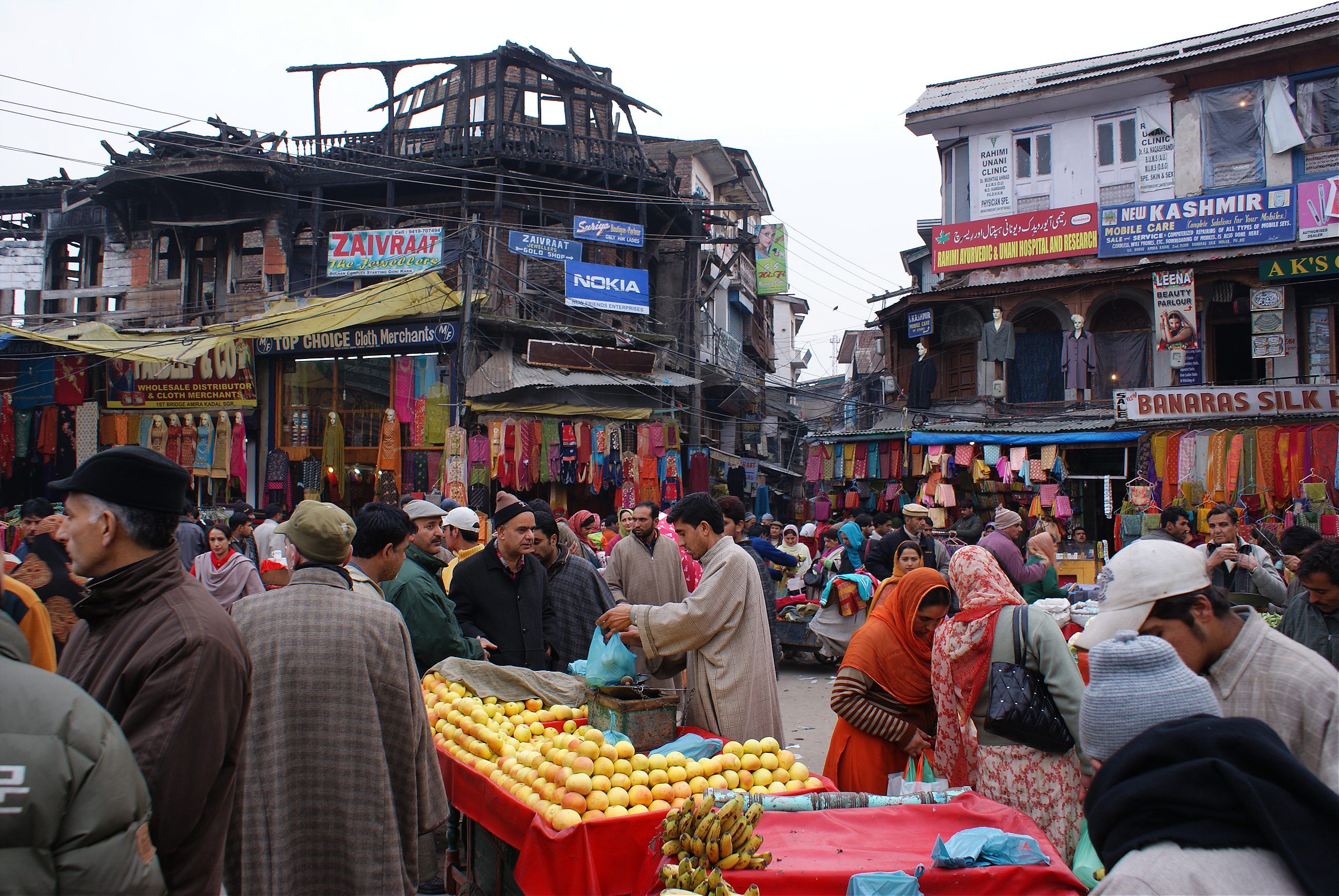Two decades after being labeled the most dangerous place on earth, Kashmir is seeking redemption and entreating foreign tourists to return.
In the last days of January, the pines blanketing the walls of the Lidder Valley are heavy with snow. The ridgelines above, obscured behind clouds, are encased in ice. Down below the Lidder River runs jade with meltwater from the northern glaciers, the late sun blushing its snowbanks crimson. As another exquisite dusk enfolds the Pahalgam Valley, one could almost forget that nineteen years ago, just north of here, a tragedy took place that would change Kashmir forever.
In the summer of 1995, in the shadow of Mount Kolahoi, the kidnapping of six western trekkers made headlines around the globe. One hiker would escape to safety. Five weeks later another member of the party, a Norwegian named Hans Christian Ostrø, turned up near Anantnag. He was beheaded, and the name of the group responsible, Al-farhan, was carved into his chest. The remaining victims—two British, an American, and a German—were never found; the only clue as to their fates came via a chilling communiqué: “You won’t even find their ashes.”
It was to be a pivotal moment in Kashmir’s fall. For a month, the world looked on in horror and Kashmir’s reputation as a pariah hardened. Five years later, Bill Clinton described the region as the “the most dangerous place on earth.”

In the years since, in Egypt, Bali, Pakistan, and elsewhere, Islamic extremists have specifically targeted tourists. But Kashmir’s image has remained particularly tarnished. After the November 2008 terrorist attack on Mumbai, which left 164 dead, many of them gunned down in the city’s most luxurious hotels, western governments issued travel warnings that last only a few weeks. Similar warnings about journeying to Kashmir have endured for over twenty years.
But in the last two years several countries, including Britain, Germany, and Japan, have begun to ease their advisories, finally responding to the overtures of Kashmir’s tourist industry, which has been entreating foreign tourists to return for years. As the region begins to emerge from its long isolation I wanted to see the place for myself. Had the region served a disproportionate penance? Or did danger still linger?
Two days in, I seemed to have my answer.

“It’s nothing,” says Muba, my local host, waving a dismissive hand toward the gathered crowd. But I’m struggling to share his nonchalance. Chanting begins. One voice at first, then several. “Azadi,” the men cry—freedom. Someone hurls a stone towards the mobile-machinegun-turret at the other end of the road. It falls short, but it’s enough to make the troops that were the rock’s intended target bristle.
Suddenly, Srinagar, Kashmir’s regional capital, doesn’t feel like much of a holiday destination anymore.
Perhaps I shouldn’t have been surprised. It’s been twenty-five years since resentment over Indian rule among Kashmir’s 95 percent Muslim population erupted into a full-blown insurgency. The ensuing conflict between separatist militants and Indian military plunged the so-called Heavenly Valley into hell, derailing its once thriving travel industry and claiming at least 47,000 lives.
This is the powder-keg we know, but it’s not the whole story. Though the border between India and Pakistan—the so-called Line of Control—remains bitterly disputed, the region has been enjoying a gradual recovery in recent years, a fragile renaissance that has seen violence wane and tourist arrivals—the overwhelming majority of which come from elsewhere in India—snowball year on year.
For a day and a half, Muba (short for Mubarak) guides me from the bustling marketplaces of Lal Chowk to the spiritual places downtown, and through the backstreets in between. He reveals a city scarred but resilient, where snapshots of ongoing strife—the charred husk of a bombed-out building, the machinegun-toting guards patrolling the emerald-green entrance to the Shah Hamdan Mosque—still look incongruous amid the everyday tumult of auto-rickshaws coughing out fumes and metalworkers hunched over copper bowls.

At a time of year when every self-respecting Kashmir man dons knee-length wool gowns, known as pherans, I stand out a mile, but my presence provokes barely a stare and certainly no ill feeling.
Only now, near the Jama Masjid, Srinagar’s austere principal shrine, do things depart from the ordinary, with a ragbag of protestors at one end of the road staring down a group of soldiers in white jackboots, some of the estimated 500,000 military personnel deployed in Kashmir to oversee a population of four million. Thankfully, today’s protest is mere posturing, dispersing almost as soon as it begins.
“We used to say that if Indian army goes pee, all of Kashmir in the water,” Muba wisecracks as we peel away onto the dusty highway that runs alongside the Jhelum River. “In the past, hundreds of soldiers on this road. Now every day there is less and less.” We walk the length of it and count no more than ten soldiers. Five years ago, Muba insists, there would have been dozens.

Two days later, we head east out of Srinagar, along a road fringed by apple orchards, mulberry plantations, and fields of saffron, and past the willow workshops of Amantipora, where lintels are laden with freshly-hewn cricket bats awaiting export across the subcontinent. Joining Muba and I in the jeep is a Frenchman named Christophe, a Kashmir veteran originally drawn by the scent of opium but who now returns for trips like this, in search of more aesthetic highs.
Kashmir owes its existence to tectonic collisions that raised it out of the ancient Tethys Sea (the name Kashmir derives from the Sanskrit meaning land desiccated from water). The result of this uplift—an oval bowl bisected by the Jhelum River and bound by the outriders of the Great Himalayas—is a beautiful landscape its inhabitants describe as ‘Paradise on Earth.’
An hour past Anantnag, the valley’s second city, the road starts to climb. Eventually we round a hairpin into a sheer-sided canyon, its walls a tapestry of conifers and couloirs, and crested by craggy ridgelines, like ocean-breakers frozen in snow. Scattered beside the torrid stream that cut this Eden are the buildings of Pahalgam, Kashmir’s principal mountain resort and starting point for the Hindu pilgrimage that goes from here to the Amarnath Cave, where Shiva is said to have imparted the meaning of the universe to his consort, Parvati.
The popularity of this 26-mile pilgrimage has helped fuel an astonishing expansion in the number of Indian tourists visiting their country’s northernmost corner. In 1995, Kashmir received just 320 domestic visitors. By 2011, the number had reached one million for the first time, a feat repeated in 2012 and 2013. Challenges still abound: the worst Monsoon floods for decades decimated the most recent summer tourist season, and each spasm of violence is met with a dip in demand.
But the general trend is clear: Hindus, the very people who, given the rancorous political backdrop, should be most deterred, are coming here in droves. For the country’s growing middle-class, Kashmir’s cooler climate offers irresistible respite from the oppressive heat of the Indian plains.
The region’s quota of foreign arrivals, by contrast, remains a trickle. For the next couple of days Christophe and I are the only westerners in sight.
We make do with short excursions—the snows mean that trekking options are limited and there is pleasure to be had in simply meandering up and down the valley, stopping to fish at each glimpse of running water. Kashmir has some of the best freshwater fishing on earth and Muba makes it look easy, brandishing his short reel-less rod like a magic wand. “Allah’s gift to the people of Kashmir,” he says, pulling out slithering quarry seemingly at will. “Man cannot create anything as beautiful as a trout.”

Our last day’s walk, spent under cloudless skies, takes us north up the valley, along a tarmac road cleared of snow. After seven miles the land spreads out into wide-open vale and at lunchtime we see the corrugated-iron roofs of Aru, a tumbledown village sitting in a natural amphitheater at the confluence of two streams. On the village outskirts, we arrive at an open-fronted convenience store where we stop to share lunch and a water-pipe with a row of leathery men who have gathered to enjoy the slapstick spectacle of two boys grappling with a pair of cross-country skis.
One of the men waves an expansive arm towards the mountains that crumple across every horizon, and says, “Welcome to Little Switzerland.”
That evening, we sit on the guesthouse veranda warmed by kangri stoves—charcoal burners held in a wicker baskets—while Muba and local guide Ghulam tell me how the nickname “Little Switzerland” alludes to an age-old dream. In pre-insurgency days people used to talk of transforming Kashmir into a Switzerland of the East, a playground of chalets and winter sport to rival the resorts of alpine Europe.
It’s an idea that those championing Kashmir as a tourism destination—foremost among them Omar Abdullah, the Essex-born scion of a political dynasty who is Chief Minister for Jammu and Kashmir state—have been trying to resuscitate for years. At travel fairs worldwide, officials have insisted that Kashmir has turned a corner, while rebranding the likes of Pahalgam and the nascent ski-resort of Gulmarg under the redemptive slogan: Paradise Once Again.
Even the most ardent separatist insists that tourists are welcome
“Kashmir,” Abdullah announced to the assembled press corps upon his election in 2009, “is open for business.”
But many remain unconvinced. Memories of 1995 and the disappeared trekkers hang like an unshakable curse over these mountains.
Abductions of foreign nationals in the Kashmir Valley began and ended with the Pahalgam atrocity. Today, even the most ardent separatist is at pains to reiterate that tourists are welcome and that they have nothing to do with their struggle. But the incident is still cited by foreign governments in justification of longstanding warnings against travel to Kashmir, viewed by many observers as the greatest hindrance to reeling in foreign tourists.
Though the last two years have seen several western governments relax their warnings for Srinagar, almost all still advise against traveling to rural areas like Pahalgam. America’s State Department, which earlier this year extended its blanket warning for the foreseeable future, continues to insist that “Foreigners are particularly visible, vulnerable, and at risk.”
“When did you last hear of a foreign tourist being targeted here?” and exacerbated an exasperated Abdullah told the Guardian in 2012. “How many British citizens did you lose in 9/11? Did you stop people from visiting New York? You’ve lost them in Spain, in Bali, tell me where you haven’t lost them.”
It’s a frustration shared by Muba and Ghulam, who believe that Kashmir has been unfairly condemned. While the West focuses on the negative, they contend, few have noticed that most Kashmiris have reconciled with the status quo and are anxious to benefit from India’s economic development.
“Kashmir is tired of the fighting,” Muba says, echoing a sentiment I hear throughout my trip. “We want only to move forward.”

Back in Srinagar, I settle into the most celebrated fixture of Kashmir’s tourist experience. For the rest of my trip, home is Mubarak’s houseboat: the Gulshan Palace. A century has passed since British civil servants commissioned local carpenters to build the first of Dal Lake’s floating guesthouses, regal refuges from the heat of the plains. The same imperative applies today. This feels like a place to forget about the world.
The days pass dreamlike: woken by Aba putting logs in my bedroom’s wood stove, breakfast with Mamma and the boisterous children. Relaxing on the balcony over Kashmiri tea, a compulsive brew infused with cinnamon and cardoman seeds.
In the afternoons, Raja, one of Muba’s many sidekicks, takes up his heart-shaped oar and invites me onto his boat to explore the Dal. We skim down the liquid avenue of Golden Lake, then over to the small island park of Char Chinar, favored by Bollywood directors for its immense backdrop of the Pir Panjal—at this time of year a bastion of foggy, snow-dusted escarpments—that hem in the lake’s northern shore. On that shore there are monuments to Kashmir’s growing confidence: the Royal Springs, one of Asia’s best golf courses; Mughal Gardens, freshly renovated; and on the little hill of Kral Sangri, a five-star hotel.

Time will tell whether such developments presage the end of Kashmir’s long time in the cold. Standing here beneath the plane trees, the prospect leaves me conflicted. For the visitor, there is a guilty pleasure to be derived from venturing to a place that others deem to be perilous. Hidden behind its veil of instability, to come here feels like stepping into a myth.
But such musings are a selfish indulgence, and scant comfort to the many thousands of Kashmiris that are anxious for foreign dollars. For beyond the politics and the barbed wire one simple truth remains: Kashmir, both as a place and a people, is made for the hosting of holidaymakers. And, today, those who choose to come here seldom regret it.